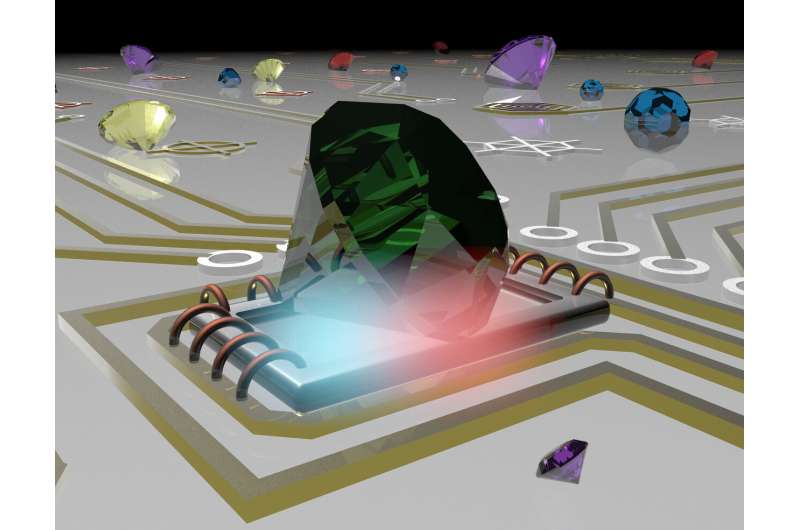A novel technique that uses quantum light to measure temperature at the nanoscale

Being able to measure, and monitor, temperatures and temperature changes at miniscule scales—inside a cell or in micro and nano-electronic components—has the potential to impact many areas of research from disease detection to a major challenge of modern computation and communication technologies, how to measure scalability and performance in electronic components.
A collaborative team, led by scientists from the University of Technology Sydney (UTS), developed a highly-sensitive nano-thermometer that uses atom-like inclusions in diamond nanoparticles to accurately measure temperature at the nanoscale. The sensor exploits the properties of these atom-like diamond inclusions on the quantum level, where the limits of classical physics no longer apply.
Diamond nanoparticles are extremely small particles—up to 10,000 times smaller than the width of a human hair—that fluoresce when illuminated with a laser.
Senior Investigator, Dr. Carlo Bradac, UTS School of Mathematical and Physical Sciences, said the new technique was not just a "proof-of-concept realisation."
"The method is immediately deployable. We are currently using it for measuring temperature variations both in biological samples and in high-power electronic circuits whose performance strongly rely on monitoring and controlling their temperature with sensitivities and at a scale hard to achieve with other methods," Dr. Bradac said.
The study published in Science Advances, is a collaboration between UTS researchers and international collaborators from the Russian Academy of Science (RU), Nanyang Technological University (SG) and Harvard University (US).
Lead author, UTS physicist Dr. Trong Toan Tran, explained that although pure diamond is transparent it "usually contains imperfections such as inclusions of foreign atoms."
"Beyond giving the diamond different colours, yellow, pink, blue, etc. the imperfections emit light at specific wavelengths [colours] when probed with a laser beam," says Dr. Tran.
The researchers found that there is a special regime—referred to as Anti-Stokes—in which the intensity of the light emitted by these diamond colour impurities depends very strongly on the temperature of the surrounding environment. Because these diamond nanoparticles can be as small as just a few nanometres they can be used as tiny nano-thermometers.
"We immediately realised we could harness this peculiar fluorescence-temperature dependence and use diamond nanoparticles as ultra-small temperature probes," Dr. Bradac said.
"This is particularly attractive as diamond is known to be non-toxic—thus suitable for measurements in delicate biological environments—as well as extremely resilient—hence ideal for measuring temperatures in very harsh environments up to several hundreds of degrees," he added.
The researchers say that an important advantage of the technique is that it is all-optical. The measurement only requires placing a droplet of the nanoparticles-in-water solution in contact with the sample and then measuring—non-invasively—their optical fluorescence as a laser beam is shone on them.
Although similar all-optical approaches using nanoparticles have successfully measured temperatures at the nanoscale, the research team believes that none have been able to achieve both the sensitivity and the spatial resolution of the technique developed at UTS. "We believe our sensor can measure temperatures with a sensitivity which is comparable—or superior—to that of the current best all-optical micro- and nano-thermometers, while featuring the highest spatial resolution to date," Dr. Tran said.
The researchers at UTS highlighted that nanoscale thermometry was the most obvious—yet far from the only—application exploiting the Anti-Stokes regime in quantum systems. The regime can form the basis for exploring fundamental light-matter interactions in isolated quantum systems at energies conventionally unexplored. It opens up new possibilities for a plethora of practical nanoscale sensing technologies, some as exotic as optical refrigeration where light is used to cool down objects.
More information: "Anti-Stokes excitation of solid-state quantum emitters for nanoscale thermometry," Science Advances (2019). advances.sciencemag.org/content/5/5/eaav9180
Journal information: Science Advances
Provided by University of Technology, Sydney




















